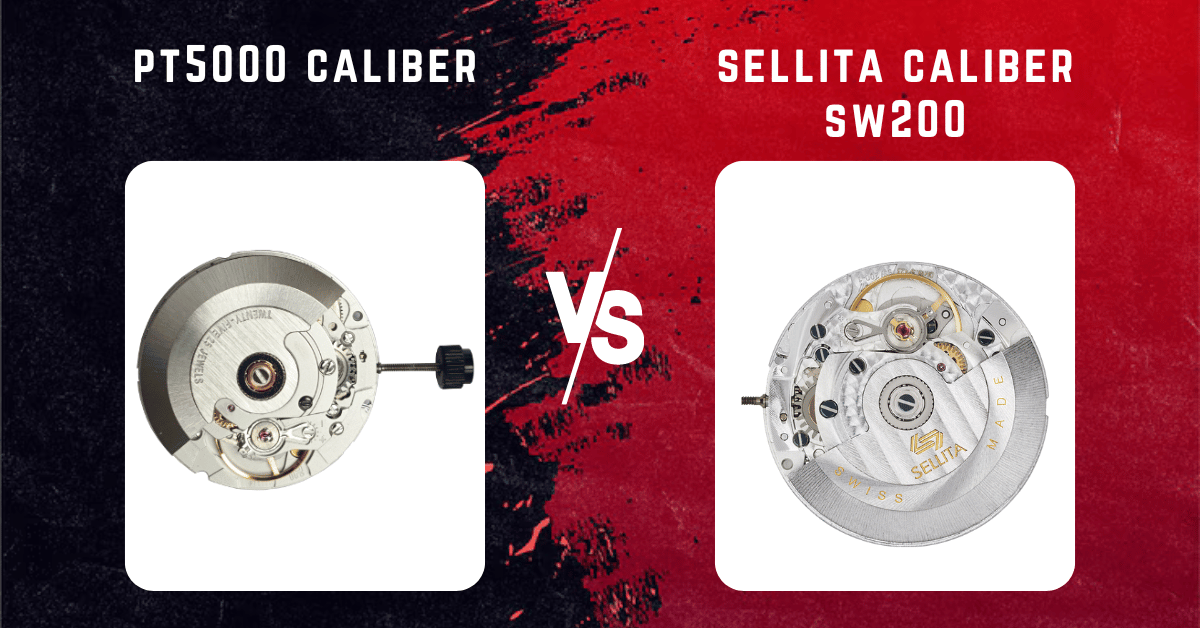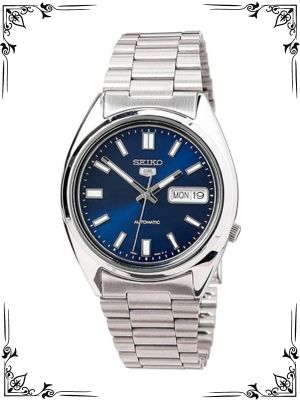In the realm of mechanical watches, the heart lies in the caliber, the intricate mechanism that keeps time ticking. When it comes to automatic movements, two contenders often capture the attention of watch enthusiasts: the PT5000 and the Sellita SW200.
Both boasting impressive lineages, these calibers offer reliable timekeeping at attractive price points. But which one reigns supreme? Let’s delve into a detailed comparison to help you make an informed decision.
Unveiling the Champions: PT5000 vs SW200
PT5000 Caliber: This automatic movement hails from China, produced by Hangzhou Watch Co., Ltd. (Seagull). It draws inspiration from the legendary ETA 2824-2, a Swiss caliber renowned for its robustness and longevity. The PT5000 incorporates modern design elements while retaining the core functionalities of its predecessor.
Sellita SW200 Caliber: This Swiss-made movement is a direct clone of the ETA 2824-2, manufactured by Sellita Watch Company SA. Following ETA’s decision to limit sales of the 2824-2 to established brands, Sellita emerged as a reliable alternative for watchmakers seeking a high-quality, Swiss-made automatic movement.
Here’s a table outlining the key specifications of both calibers:
| Feature | PT5000 Caliber | Sellita SW200 Caliber |
|---|---|---|
| Jewels | 21 | 21 |
| Beat Rate (bph) | 28,800 | 28,800 |
| Power Reserve | 40 hours | 41 hours |
| Hacking Seconds | Yes | Yes |
| Hand Winding | Yes | Yes |
| Date Function | Yes (quick-set) | Yes (quick-set) |
| Winding Mechanism | Bi-directional rotor | Bi-directional rotor |
| Height | 5.00 mm | 5.60 mm |
| Diameter | 26.00 mm | 26.00 mm |
A Deep Dive: Feature-by-Feature Analysis
Heritage and Design:
The PT5000 takes cues from the ETA 2824-2, offering a modern interpretation of a well-established design. The SW200, on the other hand, is a faithful replica of the original, ensuring Swiss-made quality and adherence to a proven blueprint.
Performance:
Both calibers boast a respectable 40-41 hour power reserve, providing ample running time when fully wound. They also share the same beat rate of 28,800 bph, resulting in a smooth sweep of the second hand for a visually pleasing experience.
Functionality:
Both calibers offer hacking seconds, allowing you to stop the second hand for a precise time setting. Additionally, they feature hand winding and a quick-set date function for added convenience.
Winding Mechanism:
Both the PT5000 and SW200 utilize bi-directional rotors, meaning they wind the mainspring as the rotor spins in either direction through wrist movement. This can potentially lead to faster winding compared to unidirectional rotors.
Serviceability and Availability:
The SW200, being Swiss-made, might enjoy a slight edge in terms of readily available replacement parts and watchmakers familiar with the movement. However, the PT5000 is gaining traction, and its serviceability is likely to improve over time.
Pros and Cons: Weighing the Options
PT5000 Caliber:
Pros:
- More affordable compared to the SW200 in most cases.
- Slightly slimmer profile due to its reduced height.
Cons:
- Less established brand name compared to Sellita.
- Potentially lower serviceability compared to the SW200 at present.
Sellita SW200 Caliber:
Pros:
- Swiss-made quality with a proven track record for reliability.
- Generally easier access to replacement parts and watchmakers with SW200 expertise.
Cons:
- Slightly higher cost compared to the PT5000.
- Slightly thicker profile compared to the PT5000.
Picking a Champion: It Depends on Your Priorities
There’s no definitive winner in the PT5000 vs. SW200 battle. The ideal choice hinges on your specific needs and preferences. Here’s a breakdown to help you decide:
Choose the PT5000 if:
- Budget is a primary concern: The PT5000 typically comes at a more attractive price point compared to the SW200.
- Slimness is a priority: The PT5000’s slightly thinner profile can translate to a more comfortable fit for some watches.
- You’re open to exploring a rising contender: The PT5000 represents a growing force in the automatic movement market.
Choose the Sellita SW200 if:
Swiss-made pedigree matters: You value the established reputation and quality associated with Swiss watchmaking.
Serviceability is a key factor: Easier access to replacement parts and watchmakers familiar with the SW200 can offer peace of mind.
You’re willing to pay a slight premium: The additional cost of the SW200 might be worthwhile for the assurance of Swiss quality.
Frequently Asked Questions
1. Are the PT5000 and SW200 calibers as accurate as high-end Swiss movements?
Both calibers offer decent accuracy, typically ranging from -10 to +15 seconds per day. While some high-end Swiss movements boast superior precision, the difference might be negligible for everyday wear.
2. Can I upgrade my watch’s movement from PT5000 to SW200 (or vice versa)?
While theoretically possible, it’s not a common practice due to the cost and potential compatibility issues. The process can be expensive due to the watchmaker’s labor and potential part incompatibility. Upgrading to a significantly different movement often requires extensive modifications to the watch case.
3. How often do I need to service my watch with either movement?
Regular servicing is crucial for maintaining your watch’s accuracy and longevity. The recommended service interval for both calibers typically falls between 5-7 years, depending on usage and environmental conditions.
4. Are there any other factors to consider when choosing a watch?
Beyond the movement, numerous aspects contribute to a watch’s overall quality and appeal. These include the case material, dial design, water resistance rating, brand reputation, and, of course, personal style.
5. Where can I find more information about these calibers?
Several online resources offer detailed specifications and discussions about the PT5000 and SW200 calibers. Watch forums, enthusiast websites, and manufacturer specifications can provide valuable insights.
Conclusion
The PT5000 and Sellita SW200 calibers are both formidable contenders in the realm of automatic movements. While the SW200 boasts a Swiss-made heritage and potentially easier serviceability, the PT5000 emerges as a compelling choice due to its affordability and slimmer profile.
Ultimately, the ideal movement depends on your budget, priorities, and preference for Swiss-made versus a rising Chinese player in the watchmaking industry. By understanding the strengths and weaknesses of both calibers, you can make an informed decision and find the perfect timepiece to suit your needs.


